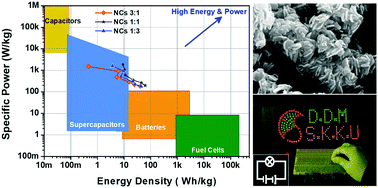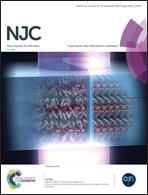Facile synthesis of a hierarchical CuS/CuSCN nanocomposite with advanced energy storage properties†
Abstract
We introduce CuS/CuSCN nanocomposites as active materials in pseudocapacitors, in which the redox reactions of both CuS and CuSCN simultaneously contribute to energy storage. This nanocomposite is prepared using an in situ methodology via facile, low-energy-consuming green nanochemistry. The CuS/CuSCN nanocomposites offer a high capacitance compared to their individual constituents. CuS nanorods (∼15 nm) are anchored on the surface of CuSCN nanosheets (∼100 nm) and they interconnect the CuSCN nanosheets, producing mesoporous nanoclusters with a large surface area, thus improving the charge transfer efficiency. The CuS/CuSCN nanocomposites exhibit high electrical conductivity and strong redox reactivity, and in particular, the pseudocapacitor with a compositional ratio of 1 : 1 exhibits the highest charge transfer efficiency. Consequently, the 1 : 1 CuS/CuSCN active material exhibits a high energy density (approximately 63 W h kg−1) and a high power density (1.9 kW kg−1 at 9.0 W h kg−1) as a single electrode. The highest specific capacitance is measured to be 1787.3 F g−1 in the single electrode. Furthermore, an aqueous asymmetric hybrid supercapacitor based on the CuS/CuSCN 1 : 1//activated carbon (AC) shows an approximately four times increase in the power density (7.9 kW kg−1), compared to the single electrode.



 Please wait while we load your content...
Please wait while we load your content...